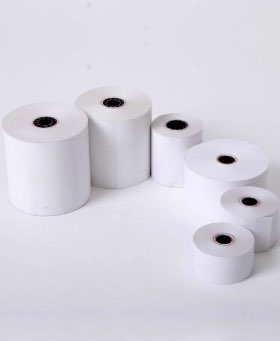
How Can You Tell if Paper is Thermal?
To the untrained eye, a thermal paper might look like any other, but it is vastly different on a closer look. If you have difficulty differentiating the two, here’s information on identifying thermal paper. Alternatively, you could contact Graphic Tickets Systems for surefire ways to identify the thermal paper.
What is a Receipt Paper Roll?

Receipt paper rolls are a particular type of paper used in receipts, the most common being thermal paper. Thermal paper rolls consist of layers of special coating and a bottom layer of plain paper, which means it is printable, courtesy of a layer of chemical dye that responds to heat.
So, as the paper passes through the printer, it causes a reaction, making it easy to print images and words on this kind of paper. Perhaps that explains why thermal receipt paper rolls are so popular.
Also read: https://graphictickets.com/everything-you-need-to-know-about-bpa-free-thermal-paper/
Types of Paper
The paper has come a long way since its invention 2000 years ago. Nowadays, we have a variety of paper types for different uses. Here are three of the most commonly used paper types:
1) Thermal Paper
Thermal paper is a particular type of paper that needs heat to print. It is more affordable than regular paper, which requires ink for printing. Thermal paper has a chemical coating that changes color when exposed to heat. The paper type has a base, precoat, and a thermal layer, offering good image stability.
However, it is susceptible to moisture and oil. You won’t have to worry about smears because the smudge-free print and high-definition results are essential for receipts. Also, check the link here if you’re concerned about certain factors before purchasing thermal papers.
2) Bond Paper
Bond paper is a durable writing paper used in offices to create contracts, reports and proposals, cover letters, brochures, and more. Bond paper is typically more robust and durable than regular paper.
This paper type is resistant to ink spreading and penetrating, making it suitable for long-term printing. It is one of the best papers to use because of its bright color output, resistance to fading, and cleanliness.
Bond paper is particularly ideal for making cards, menus, and tags but isn’t suitable for printing sophisticated or durable items.
3) Carbonless Paper
Carbonless paper is a type of paper that transfers content from the top pages to the ones below. It is also commonly referred to as NCR paper, which stands for No Carbon Required Forms. Carbonless paper printouts are not as durable, with a lifespan of about two years, after which they begin to fade.
However, this paper type is biodegradable and stain-free, making it an environmentally friendly option compared to carbon paper. To use this paper, place it on top of another sheet and apply pressure. The pressure causes a chemical reaction that results in an image transfer.

Carbonless paper is suitable for copying legal forms, bank checks, employment applications, service tickets, and other statement documents. One major downside is that it is more expensive than carbon copy paper.
For another type of paper you can also read: https://graphictickets.com/what-is-two-sided-thermal-paper/
How to check Thermal Paper?
It is difficult to identify the type of paper by simply looking at it; that’s why we’ve come up with these bulletproof methods on how to identify thermal paper,
a) Scratch with Your Fingernail
Scratching with your fingernail is the easiest way to determine whether a paper is thermal. Since thermal paper has a chemical coating on the surface, it generates heat when you scratch it. As a result of the heat, the paper will produce black marks.
To determine whether you have genuine thermal paper, it would help to try the scratch test on both sides of the paper. If none turn black, then you most likely have regular paper. On the other hand, if your scratching results in black marks, that is thermal paper.
Understand this factor better by clicking on the link here.
b) Observe and Feel the Paper Surface
Observing or feeling the paper surface is another way to determine whether a paper is thermal or regular. Thermal paper typically has a shinier and smoother surface than other paper types like carbonless and bond paper.
However, this is not always a foolproof way to determine whether a paper is thermal. That’s because some types of bond paper are just as smooth and shiny.
Also read: https://graphictickets.com/what-are-cash-register-paper-rolls/

c) Fire Roasting
Another neat trick is heating the back of the thermal paper. Use a lighter to roast the back lightly, and if it changes color and gradually fades to its surroundings, it is thermal paper.
d) Test the Paper on Thermal Printer
Using a thermal printer is another great way to identify thermal paper. Thermal printers produce text or images on thermal paper without using ribbons. Using regular paper in a thermal printer will not produce any results.
The whole anatomy of thermal paper indeed sounds interesting, right? However, if you want to be a geek of thermal rolls, check: https://graphictickets.com/all-you-need-to-know-about-thermal-paper/
Conclusion
Thermal paper forms an integral part of many financial transactions. People need thermal paper receipts to keep track of spending and proof of a transaction. Choose Graphic Tickets & Services for the highest quality of thermal receipts paper.
















